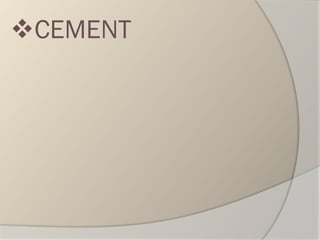Cement is produced by heating limestone and clay in a kiln to form clinker, which is then ground with gypsum. There are two main types: hydraulic cement hardens when mixed with water due to a chemical reaction, while non-hydraulic cement hardens through carbonation. The Romans used early forms of concrete and cement in structures like the Colosseum. Modern cement production involves mining raw materials, grinding and heating them to form clinker, and then grinding the clinker to produce cement powder. Cement is used primarily in concrete and mortar for construction of buildings, roads, bridges and other infrastructure.































